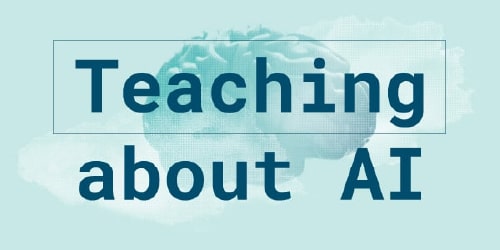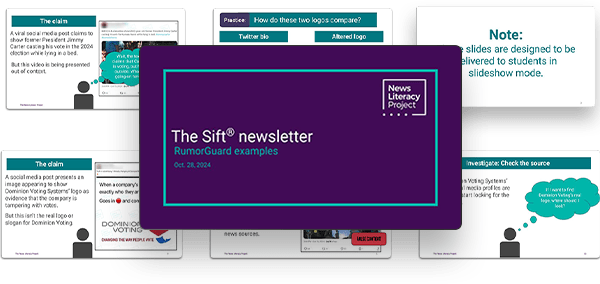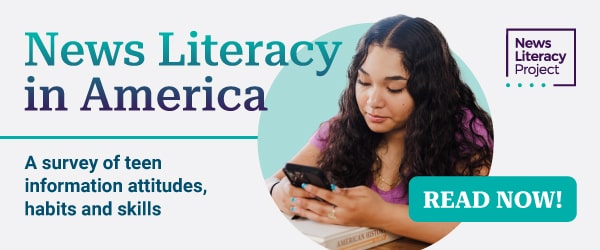The Sift: ‘AI slop’ | Blocked endorsements
 Daily Do Now slidesDon't miss this week's classroom-ready resource.  |
Top picks
{{Salutation or 'Educators'}}, this section highlights the latest news literacy topics and ways to integrate them into your classroom.


| Investigations found no widespread election fraud in 2020, yet the false narrative persists. Illustration credit: The News Literacy Project. |
1. Election misinformation flourishes
In the final days ahead of the U.S. presidential election, conspiracy theories and false claims about voting machines, election fraud, noncitizens voting and the candidates themselves have surged. One election official told The Associated Press that countering election misinformation was “like playing whack-a-mole with truth.”
Election mis- and disinformation comes from a variety of sources, including some politicians, social media posts and foreign influence campaigns. X owner Elon Musk has repeatedly shared falsehoods about 2020 election fraud and content from Tenet Media — a news outlet that federal prosecutors say used $10 million in laundered funds from Russian operatives.
| Discuss: |
Why is it important to counter election misinformation? What effects do false election narratives have on the democratic process? What factors cause emotionally charged content to go viral online, and how does it impact how we engage with social media?
| Idea: |
Use the “News or not?” slide in Week 7 of the Daily Do Now resource for students to think more about this issue. This slide includes a short activity adapted from a Washington Post misinformation quiz (link warning: profanity).
| Related: |
- ”‘Firehose’ of election conspiracy theories floods final days of the campaign” (Matt Vasilogambros, Stateline).
- “Microsoft Warns Foreign Disinformation Is Hitting the US Election From All Directions” (Lily Hay Newman, Wired).
- “AI is already making it easier to spread election lies” (Sam Sabin, Axios).
★ NLP Resources:


“Misinformation” (Checkology® virtual classroom).
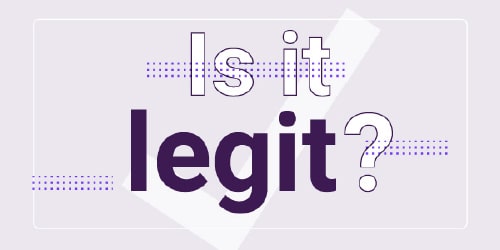

Infographic: “Is it legit? Five steps for vetting a news source”
2. Local newspapers disappear; digital outlets increase
About 55 million Americans have little to no access to local news as “news deserts” continue to spread, a recently published annual report from Northwestern University’s Medill School of Journalism found. Within the last year, 127 local newspapers closed in the U.S. But one bright spot highlighted in the report was the growth of standalone digital news sites, with a net increase of 81 outlets — of which 30 were newspapers that ended print editions and converted to online only.
The report also noted that nearly 90% of local news startups are digital-only, and most are in urban and suburban areas.
| Idea: |
Ask students to brainstorm local issues that are important to them, whether it’s new school policies, sports or community events. Then, determine what, if any, local sources provide information about these issues. If your school is in a news desert, assign a local news story to students in print or video form. Ask them to include information from at least two sources and follow editorial standards for quality journalism.
| Another idea: |
Use the ”News decline” slide in Week 7 of the Daily Do Now resource for students to think more about this issue.
| Related: |
- “In US, fake news websites now outnumber real local media sites” (Robin Guess, Voice of America).
- “Local news sources are still drying up, but there’s growth in digital sites in metro areas” (David Bauder, The Associated Press).
- “Meet the Florida Billionaire Who Wants to Be a Newspaper Baron” (Benjamin Mullin, The New York Times).
★ NLP Resource:


“Practicing Quality Journalism” (Checkology virtual classroom).
3. Autumn-themed ‘AI slop’ floods social media
AI-generated images on Pinterest of pumpkin spice lattes may give cozy autumn vibes, but they’re not as harmless as they appear. One tech expert (link warning: mild profanity) explained in a Vox interview that “AI slop” — a term used to describe spammy AI-generated content online that incentivizes engagement above all else — clogs social media feeds and desensitizes people’s abilities to determine authentic from synthetic content. AI slop is often produced by people aiming to go viral and profit from quick and cheap content.
| Discuss: |
What are the challenges of separating AI-generated images, audio and video from authentic content? What is the purpose of AI slop? How does AI slop affect social media users? Why might certain tech companies be supportive of AI slop on platforms?
| Related: |
- “AI-generated images have become a new form of propaganda this election season” (Huo Jingnan, NPR).
★ NLP Resources:
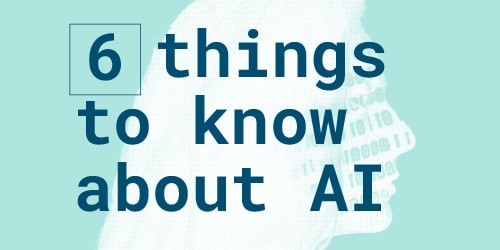

Infographic: “6 things to know about AI”


“Introduction to Algorithms” (Checkology virtual classroom).


Dominion Voting’s logo altered to spread election fraud claims
![A post on Facebook reads, “Truth in advertising! Already changing in Georgia! But it never happens and we are just paranoid.” The post also includes a meme that reads, “When a company’s logo says exactly who they are. Goes in [red circle] and comes out [blue circle]” and features a doctored version of Dominion Voting’s logo along with the fabricated slogan, “CHANGING
THE WAY PEOPLE
VOTE.” The News Literacy Project has added a label that says, “DOCTORED IMAGE.”](https://newslit.org/wp-content/uploads/2024/10/rg1-102824-min.png)
![A post on Facebook reads, “Truth in advertising! Already changing in Georgia! But it never happens and we are just paranoid.” The post also includes a meme that reads, “When a company’s logo says exactly who they are. Goes in [red circle] and comes out [blue circle]” and features a doctored version of Dominion Voting’s logo along with the fabricated slogan, “CHANGING
THE WAY PEOPLE
VOTE.” The News Literacy Project has added a label that says, “DOCTORED IMAGE.”](https://newslit.org/wp-content/uploads/2024/10/rg1-102824-min.png)
❌ NO: This is not Dominion Voting’s genuine logo or slogan.
✅ YES: Dominion Voting’s slogan is “Accurate. Reliable. Transparent.”
★ NewsLit takeaway
Dominion Voting Systems has long been a target of those who spread misinformation. This altered logo, for example, first circulated during the 2020 presidential election and continues to spread online now, with new unfounded claims of election fraud. During election season, keep in mind:
- Sensational claims deserve extra scrutiny. Visit the Dominion Voting website or search for credible news reports to find important context.
- While claims of election fraud are common online, evidence shows it’s rare and typically involves individual voters, not companies or election officials.
- Partisan sources share partisan information. Remember to check sources and consider if they are trustworthy.
Video of Jimmy Carter ‘voting’ shared out of context with false fraud claims
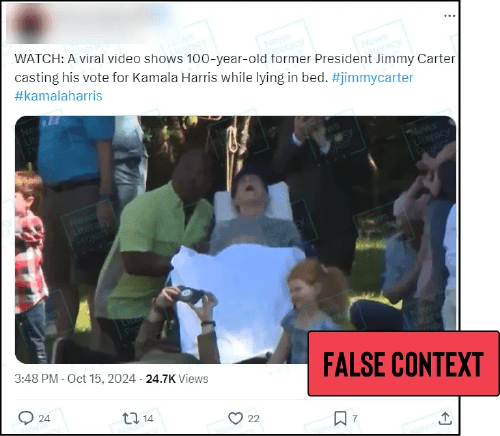

❌ NO: This video does not show former President Jimmy Carter casting his vote on the first day of early voting in Georgia on Oct. 15.
✅ YES: Carter’s family said he planned to vote for Vice President Kamala Harris.
✅ YES: This video originally aired Oct. 1 and shows Carter celebrating his 100th birthday in his Plains, Georgia, backyard with family and friends.
✅ YES: The Carter Center said in a statement that Carter voted by mail on Oct. 16.
★ NewsLit takeaway
Removing a video or photograph from its original context and presenting it with a false claim is a common misinformation tactic. Here are a few things to consider when dealing with false context rumors.
- Check if the content matches the description. In this case, while the text mentions voting, nothing in the video relates to voting.
- Do a reverse image search to determine the original context of the viral claim.
- For videos, you may need to first capture a still image from the clip to do the search.


| The Washington Post is not making a presidential endorsement for the first time since the 1980s. Its newsroom — which operates separately from its editorial board — reported that the decision was made by the paper’s owner and Amazon founder Jeff Bezos. Similarly, California’s largest newspaper, the Los Angeles Times, was also allegedly blocked by its owner from making a presidential endorsement in this year’s election. As a result, editorial staff resigned at both papers and The Post had 200,000 canceled subscriptions. Note: For resources to teach about political endorsements from news outlets, check out the Oct. 7 issue of The Sift. |
|
| Anxiety, busyness, lack of political interest and distrust of journalists are some of the reasons why 43% of Americans say they avoid the news. Researchers say news avoiders have lower rates of political participation. | |
| Think social media accurately reflects reality? Think again. Researchers say it’s more like a “funhouse mirror” warped by the outspoken views of an extreme minority — which can fuel perceptions that people are far more extreme in the real world than they actually are. | |
| If re-elected, former President Donald Trump has threatened to jail journalists and remove TV news networks’ broadcasting licenses for unfavorable coverage. | |
| Campus police detained a student journalist covering anti-war protests at the University of Minnesota — despite the fact that he was wearing a press vest. | |
| Nearly 400 teenagers recently detailed their relationship with news in a New York Times forum, including one who wrote that “media literacy and lateral reading is becoming increasingly necessary” for navigating online information. (Note: Several educators cite NLP as a resource they use.) | |
| You’ve likely seen the work of a “clipper” — someone who watches hours of campaign events and newscasts looking for attention-grabbing clips to go viral on social media. Video clipping has become a more prominent factor this election season as audiences continue to move online, according to CNN’s Brian Stelter. | |
| Sounds like Chris Rock, looks like Chris Rock, but … it’s not Chris Rock. This public service campaign uses celebrity deepfakes (and real actors) to warn against AI-generated election misinformation. |
Thanks for reading!
Your weekly issue of The Sift is created by Susan Minichiello (@susanmini), Dan Evon (@danieljevon), Peter Adams (@PeterD_Adams), Hannah Covington (@HannahCov) and Pamela Brunskill (@PamelaBrunskill). It is edited by Mary Kane (@marykkane) and Lourdes Venard (@lourdesvenard).
You’ll find teachable moments from our previous issues in the archives. Send your suggestions and success stories to [email protected].


